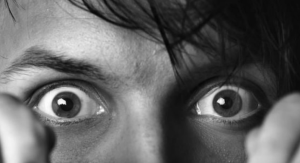There is a major superstition about Sanpaku Eyes on the internet. If you have heard this word, let’s look at the details about the Sanpaku Eyes Meaning.
Sanpaku Eyes Meaning – Introduction
Among many superstitions that exist in the digital world, Japanese superstitions are the oldest. The term Sanpaku is a Japanese term consisting of two parts: San and Paku. The phrase Sanpaku means three white. Before we proceed, let me share the info that the white part of our eye is known as Sclera. If your sclera is visible above and below the iris, this eye feature is known as Sanpaku Eyes. Other than being a biological feature, Sanpaku has a lot of hidden meanings that are applicable to your physical health and personality.

Sanpaku Eyes Meaning
Classification of Sanpaku Eyes
Sanpaku eyes are also further divided into two types. This classification is based on the part of the visible Scelra in our eyes.
Yin Sanpaku
If your Scelar is visible under the iris, you fall under the Yin Sanpaku category. These types of eyes are most common around the world and catch people’s attention. Yin Sanpaku Eyes appear to be anxious and wide.
Yang Sanpaku
People with Scelar visible above the iris fall under the Yang Sanpaku category. These types of eyes are less common worldwide. In normal situations, they appear aggressive and intense.
Origin of Sanpaku Eyes Meaning
The concept of Sanpaku eyes is a long-standing tradition and Superstition in Japan. But if we were to trace the origin of this concept to the rest of the world, we could credit George Ohsawa with introducing it to the world. George is the founder of modern macrobiotics. George believed that Sanpaku Eyes can tell a lot about a person’s emotional state and physical well-being.
Sanpaku Eyes Meaning
Understanding the origin and the details behind the concept of Sanpaku is important. However, the hidden meaning behind superstition holds the highest place in the list of essential tasks today.
Yin Sanpaku Eyes Meaning
We understand that if the white part of your eye is visible below the iris, you are in the Yin Sanpaku category. This condition indicates that you are emotionally fragile. According to traditional beliefs, if you have Yin Sanpaku eyes, the following challenges may appear in your life.
Emotional Stability
We need to control our emotions. Thus, if life throws challenges at us, we tackle them with confidence instead of losing our ground. Yin Sanpaku suggests that you don’t have a strong grounding and can struggle with anxiety and fear. Here, the Sanpaku eyes indicate that you must practice emotional stability in life to grow.
Health Concerns
As a result of low grounding and stress, your body will remain in a state of imbalance. This body condition may also suggest that your diet is unhealthy and you need to exercise to bring order to your life.
Suspect to Danger
Ancient myths and beliefs link all the parts of a superstition to each other. As a result of imbalance, you can make many wrong decisions in life. These decisions can lead to many suspects in danger, which can be physical in the form of accidents. Thus, the message here is to be more cautious in your life.
Yang Sanpaku Eyes Meaning
Now, we divert our attention to the other category of the Sanpaku eyes. If the white part in your eye is visible above the iris, you are under the Yang Sanpaku category. These eye categories suggest that a person is going through internal turmoil and are believed to be a very concerning category of Sanpaku Eyes.
Intense Energy
These people have more intense personalities and struggle with controlling their emotions. Thus, they experience high anger and aggression.

Sanpaku Eyes
Potential for Harm
Now, let’s link their intense energy with the potential results. This type of person can’t control their anger and aggression. Thus, as a result, a Yang Sanpaku Eye person can be harmful to others and themselves. These people can also perform violent activities.
Inner Struggle
Experts suggest that these people are always experiencing an inner struggle. Due to this inner struggle, they are seen as conflicted and emotional. As a result, you can see some unpredictable behavior in these people.
Scientific Perspective of Sanpaku Eyes
Scientists don’t back any ancient claims and superstitions about Sanpaku Eyes’ Meaning. The experts believe that the difference in Sclera’s visibility may be due to a few reasons.
Genetics
According to scientists, the primary reason behind Sanpaku eyes is genetics. The shape of your eyes, genes, and eyelids are the primary reasons behind the visible area around your iris.
Fatigue
If you have experienced consistent fatigue for a few days, the visible area around the iris will be prominent.
Emotional State
Consistent stress and anxiety also create a major difference in your eyes as well.
Modern Interest in Sanpaku Eyes Meaning
The internet and social media are fascinated by mystique, fate, and ancient beliefs these days. Some groups on social media see beliefs as a way to tell a person’s personality. Many groups feel attracted to the shape and view of the eyes due to the visible white space.
Social media groups are the reason behind this belief’s resurfacing in the modern world. Although there is no scientific evidence to back the claims about a person’s personality, Sanpaku eyes are accepted worldwide.
More Info: NTM Meaning Slang – A Breakdown of the Latest Internet Lingo
FAQs
Following are some frequently asked questions about Sanpaku Eyes.
1- What are Sanpaku Eyes?
Sanpaku Eyes is a unique feature of the human eye in which the white part of the eye is visible above or below the iris.
2- What is the meaning of Sanpaku eyes?
The Sanpaku Eyes phenomenon shares details about a person’s emotional state, vulnerability, and fatigue.
3- Can Sanpaku Eyes change over time?
Yes, Sanpaku Eyes can change due to your health, fatigue, anxiety, and emotions.
Final Thoughts
Now we understand that Sanpaku eyes are more than a unique biological feature of a human eye. There is a thought process and belief behind the distinctive feature.




